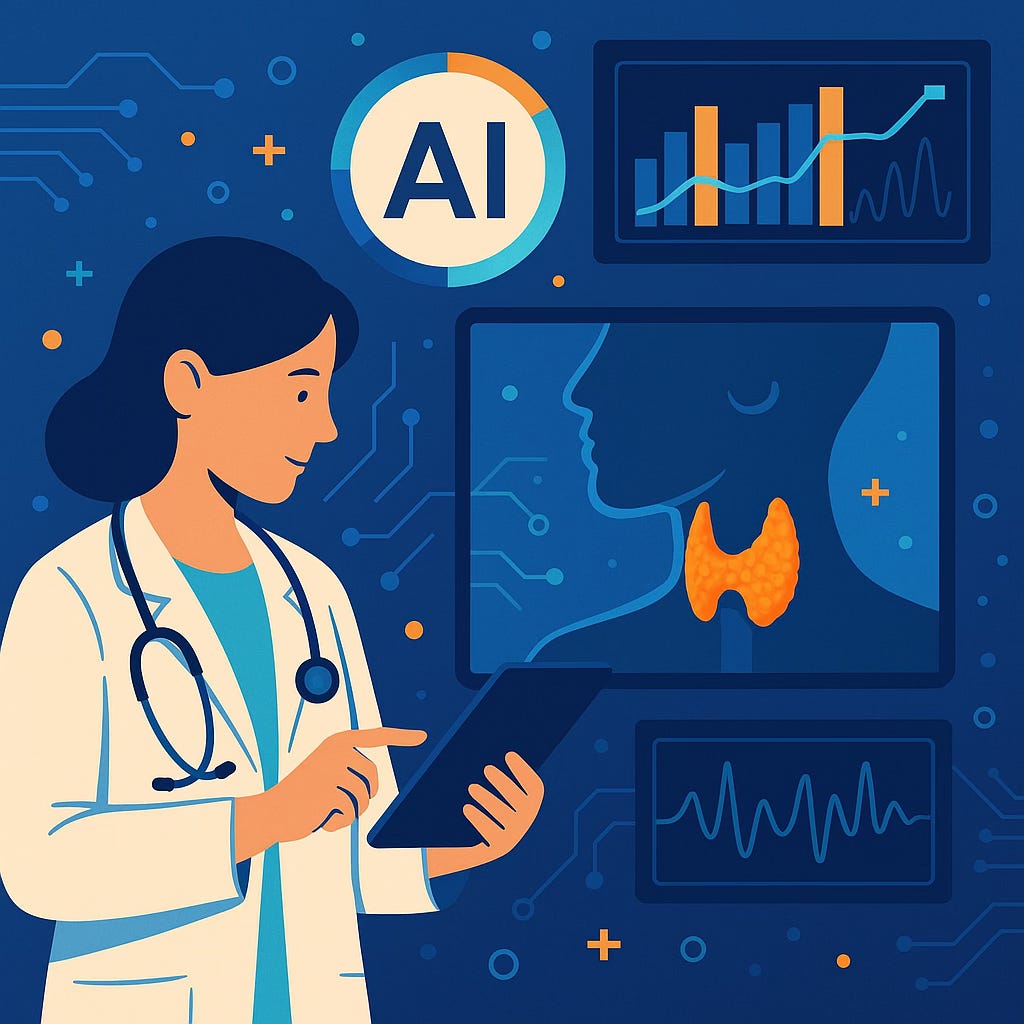AI in Thyroid Care: A Quiet Revolution in Endocrinology
Welcome to Medical AI Advancements — your trusted guide to real-world breakthroughs in AI-driven healthcare.
🧠 The Thyroid Challenge: Common Yet Often Misdiagnosed
Thyroid disorders are among the most prevalent endocrine conditions worldwide, affecting an estimated 200 million people — yet they are notoriously underdiagnosed. Conditions like hypothyroidism, hyperthyroidism, thyroid nodules, and thyroid cancer often present with vague, overlapping symptoms: fatigue, mood swings, weight fluctuations, hair thinning, and more.
These symptoms can be mistaken for stress, aging, or unrelated chronic issues, delaying diagnosis and treatment. Add to that a shortage of specialized endocrinologists in many regions, and the challenge becomes clear: thyroid care needs innovation — fast.
At HealthCity Vistaar Hospital in Lucknow, India, a new model is taking shape. By integrating artificial intelligence into diagnostic and treatment pathways, the hospital is redefining how thyroid disorders are detected, monitored, and managed.
🤖 The Breakthrough: AI-Enhanced Thyroid Diagnosis
During a public health event commemorating World Thyroid Day (May 25, 2025), HealthCity Vistaar Hospital unveiled how AI tools are transforming endocrine diagnostics. The hospital is leveraging advanced AI algorithms that interpret thyroid function tests, imaging data, and even real-time symptom reports to accelerate and enhance diagnostic accuracy.
How it Works:
🧬 AI algorithms scan TSH, T3, T4 lab values, compare them against population-level trends, and flag anomalies instantly.
🧠 Natural Language Processing (NLP) is used to analyze patient-reported symptoms via digital interfaces or clinician notes.
📈 Predictive modeling helps estimate the likelihood of flare-ups or progression in patients with nodules or autoimmune thyroid disease.
📊 Decision support tools offer tailored treatment recommendations — including dosing adjustments for levothyroxine or antithyroid medications — based on age, gender, weight, and concurrent conditions.
In real-time, the AI system supports clinicians by surfacing insights they might otherwise miss — not to replace them, but to amplify their clinical judgment.
🏥 From Hospital Labs to Personal Devices: AI for Patients
What makes this approach even more revolutionary is its patient-facing functionality. Beyond clinician dashboards, AI tools are being integrated into:
Mobile health apps that track symptoms, recommend lab tests, and guide lifestyle adjustments.
Wearable devices that monitor signs like heart rate, sleep patterns, or voice changes (an early marker for thyroid dysfunction).
AI-powered chatbots trained to answer thyroid-related queries and direct patients to care when necessary.
These tools empower patients to take ownership of their condition — a massive shift in chronic disease management. By creating intelligent feedback loops between patients and providers, AI is closing the gaps in monitoring and follow-up that have plagued thyroid care for years.
📍 Real-World Impact: The Lucknow Model
At HealthCity Vistaar, the impact is tangible:
📍 Diagnostic turnaround times have been significantly reduced, allowing faster treatment initiation.
📍 Personalized treatment plans are improving medication adherence and long-term outcomes.
📍 Targeted community outreach has increased screenings among high-risk groups, especially pregnant women and children, where untreated thyroid issues can have serious developmental consequences.
These outcomes were highlighted during the hospital's recent awareness campaign, which combined AI-powered free thyroid screenings with public education initiatives. The initiative reflects a broader commitment to democratizing access to advanced diagnostics in underserved regions — a model with global relevance.
🔮 Looking Ahead: AI's Role in Endocrinology
While this case study centers on thyroid care, it hints at broader transformations in endocrinology:
📌 Diabetes management could see similar advances using AI for continuous glucose monitoring and insulin dosing optimization.
📌 Hormonal imbalances and fertility care could benefit from AI-enhanced cycle tracking and hormone pattern analysis.
📌 Rare endocrine tumors could be detected earlier with AI imaging and predictive modeling tools.
The future of endocrine care is not about eliminating the doctor — it’s about arming doctors (and patients) with tools that can see patterns in data no human could detect alone.
📬 Key Takeaways
✅ AI is improving the speed, accuracy, and personalization of thyroid disorder diagnosis and treatment
✅ HealthCity Vistaar Hospital is leading by example with community-focused AI deployments
✅ Wearables, apps, and chatbots are helping patients take charge of their thyroid health
✅ The future of AI in endocrinology is expansive — from diabetes to fertility to rare disorders
🔗 Final Word
AI in thyroid care may not make headlines as often as robotic surgery or AI-designed drugs — but it may be one of the most impactful quiet revolutions in modern medicine. It touches millions of lives, simplifies complex diagnostics, and bridges critical gaps between patients and care.
As we continue to track how AI reshapes healthcare from the inside out, this story from Lucknow reminds us: the next big thing in medicine might already be quietly saving lives.
Enjoyed this post?
👉 Subscribe to Medical AI Advancements for weekly insights into how AI is transforming medicine — from diagnostics to delivery.
📤 Forward this issue to a colleague or patient advocate.
💬 Have feedback or insights? Hit reply and join the conversation.
—
Andrew Duggan
Founder, Medical AI Advancements




